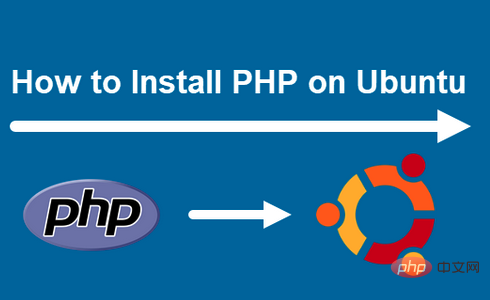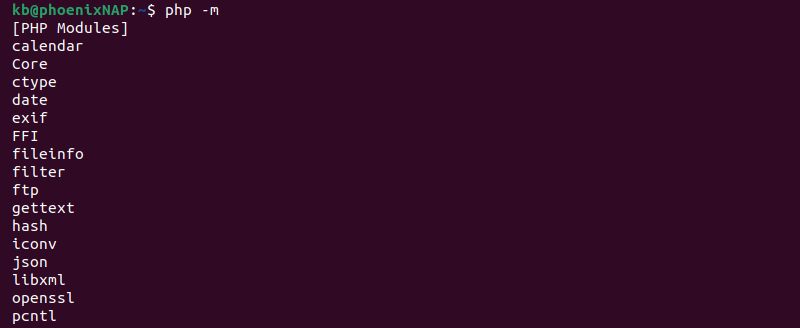Introduction
PHP stands for Hypertext Preprocessor, and it's a script-based server-side programming language.
PHP helps automate various server tasks. It handles tasks such as dynamic content, database requests, and data preprocessing/display.
Read our tutorial on how to install PHP on Ubuntu 20.04 or 22.04 including integration with Apache and Nginx.

Installing PHP on Ubuntu
Like many developer tools, PHP has several different release versions. At the time of writing, PHP 7.4. and 8.1 are the currently supported and most used versions of the software.
The following command installs PHP using the apt package manager:
sudo?apt?install?php
On Ubuntu 20.04, the command installs PHP 7.4 while Ubuntu 22.04 installs PHP version 8.1.
If you're looking to choose the specific version of PHP on either system, follow one of the installation steps below.
1. Install PHP with Apache on Ubuntu
If you are running an Apache web server, install PHP with the Apache module. Below you will find installations for both PHP 7.4 and PHP 8.1.
1. Ensure you are using the latest repository updates by entering the following command into a terminal window:
sudo?apt?update?&&?sudo?apt?upgrade
2. Install software-properties-common to help you manage distributions and independent software sources:
sudo?apt?install?software-properties-common
If the package is already available, continue to the next step.
3. Next, add the ondrej/php PPA which provides different PHP versions for Ubuntu:
sudo?add-apt-repository?ppa:ondrej/php
After the PPA loads, press Enter to confirm adding the repository. The available PHP versions in the PPA are from 5.6 up to 8.2.
4. Update apt to include the new packages:
sudo?apt?update
5. Now you can install specific PHP versions. For example:
- To install PHP 7.4, run the command:
sudo?apt?-y?install?php7.4
- To install PHP 8.1, run the following command:
sudo?apt?-y?install?php8.1
6. Verify the installation with:
php?-v
The output displays the PHP version you installed.
If you installed version 7.4, the output appears as in the image below.

If you installed PHP 8.1, the output shows:

2. Install PHP with Nginx on Ubuntu
The Nginx server does not have native PHP processing. If you are using an Nginx server instead of Apache, follow the steps below to install PHP 7.4 or 8.1 to work with Nginx.
1. Enter the following command into a terminal window to ensure you are using the latest software:
sudo?apt?install?php
2. Add the ondrej/php PPA to include various PHP versions:
sudo?apt?update?&&?sudo?apt?upgrade
When the PPA information loads, press Enter to continue.
2. To install PHP for Nginx, use one of the following commands:
- For PHP 7.4:
sudo?apt?install?software-properties-common
- For PHP 8.1:
sudo?add-apt-repository?ppa:ondrej/php
The system will reach out to download and install the package and its dependencies.

2. Once the installation finishes, restart the Nginx service to apply the changes by entering:
sudo?apt?update
3. Next, enable PHP support by editing the server block. Open the server block with the command:
sudo?apt?-y?install?php7.4
4. Add the following code to your server block file for Nginx to make use of PHP:
sudo?apt?-y?install?php8.1
Exchange the
4. Save the file and exit.
5. Finally, restart Nginx on Ubuntu and reload PHP:
php?-v
sudo?apt?update?&&?sudo?apt?upgrade
Installing PHP Modules on Ubuntu
To install additional PHP modules, use the following syntax:
sudo?add-apt-repository?ppa:ondrej/php
For example:
sudo?apt?install?php7.4-fpm?-y
Alternatively, install multiple modules at once. For example, to install modules mysql, zip and bcmath on PHP 7.4, you would run:
sudo?apt?install?php8.1-fpm?-y
To list all loaded PHP modules run the command:
sudo?systemctl?restart?nginx
The output lists all compiled PHP modules, as in the example below.

How to Uninstall PHP on Ubuntu
To uninstall PHP from Ubuntu, follow the instructions below:
1. Run the following command in the terminal:
sudo?nano?/etc/nginx/sites-available/default
For example, if you installed the PHP 7.4 FPM version, run:
server{
??#?.?.?.?existing?configuration
??location?~?.php$?{
????include?snippets/fastcgi-php.conf;
????fastcgi_pass?unix:/run/php/php<version>-fpm.sock;
??}
}</version>
2. Remove the orphaned packages with:
sudo?systemctl?restart?nginx
3. Lastly, check the PHP version to confirm the uninstall worked:
sudo?systemctl?reload?php<version_number>-fpm</version_number>
If the output does not show the version, the uninstall removed everything correctly.
The above is the detailed content of How To Install PHP On Ubuntu. For more information, please follow other related articles on the PHP Chinese website!

Hot AI Tools

Undress AI Tool
Undress images for free

Undresser.AI Undress
AI-powered app for creating realistic nude photos

AI Clothes Remover
Online AI tool for removing clothes from photos.

Clothoff.io
AI clothes remover

Video Face Swap
Swap faces in any video effortlessly with our completely free AI face swap tool!

Hot Article

Hot Tools

Notepad++7.3.1
Easy-to-use and free code editor

SublimeText3 Chinese version
Chinese version, very easy to use

Zend Studio 13.0.1
Powerful PHP integrated development environment

Dreamweaver CS6
Visual web development tools

SublimeText3 Mac version
God-level code editing software (SublimeText3)

Hot Topics
 A Simple Guide to PHP Setup
Jul 18, 2025 am 04:25 AM
A Simple Guide to PHP Setup
Jul 18, 2025 am 04:25 AM
The key to setting up PHP is to clarify the installation method, configure php.ini, connect to the web server and enable necessary extensions. 1. Install PHP: Use apt for Linux, Homebrew for Mac, and XAMPP recommended for Windows; 2. Configure php.ini: Adjust error reports, upload restrictions, etc. and restart the server; 3. Use web server: Apache uses mod_php, Nginx uses PHP-FPM; 4. Install commonly used extensions: such as mysqli, json, mbstring, etc. to support full functions.
 Learning PHP: A Beginner's Guide
Jul 18, 2025 am 04:54 AM
Learning PHP: A Beginner's Guide
Jul 18, 2025 am 04:54 AM
TolearnPHPeffectively,startbysettingupalocalserverenvironmentusingtoolslikeXAMPPandacodeeditorlikeVSCode.1)InstallXAMPPforApache,MySQL,andPHP.2)Useacodeeditorforsyntaxsupport.3)TestyoursetupwithasimplePHPfile.Next,learnPHPbasicsincludingvariables,ech
 Writing Effective PHP Comments
Jul 18, 2025 am 04:44 AM
Writing Effective PHP Comments
Jul 18, 2025 am 04:44 AM
Comments cannot be careless because they want to explain the reasons for the existence of the code rather than the functions, such as compatibility with old interfaces or third-party restrictions, otherwise people who read the code can only rely on guessing. The areas that must be commented include complex conditional judgments, special error handling logic, and temporary bypass restrictions. A more practical way to write comments is to select single-line comments or block comments based on the scene. Use document block comments to explain parameters and return values at the beginning of functions, classes, and files, and keep comments updated. For complex logic, you can add a line to the previous one to summarize the overall intention. At the same time, do not use comments to seal code, but use version control tools.
 Tips for Writing PHP Comments
Jul 18, 2025 am 04:51 AM
Tips for Writing PHP Comments
Jul 18, 2025 am 04:51 AM
The key to writing PHP comments is to clarify the purpose and specifications. Comments should explain "why" rather than "what was done", avoiding redundancy or too simplicity. 1. Use a unified format, such as docblock (/*/) for class and method descriptions to improve readability and tool compatibility; 2. Emphasize the reasons behind the logic, such as why JS jumps need to be output manually; 3. Add an overview description before complex code, describe the process in steps, and help understand the overall idea; 4. Use TODO and FIXME rationally to mark to-do items and problems to facilitate subsequent tracking and collaboration. Good annotations can reduce communication costs and improve code maintenance efficiency.
 Mastering PHP Block Comments
Jul 18, 2025 am 04:35 AM
Mastering PHP Block Comments
Jul 18, 2025 am 04:35 AM
PHPblockcommentsareusefulforwritingmulti-lineexplanations,temporarilydisablingcode,andgeneratingdocumentation.Theyshouldnotbenestedorleftunclosed.BlockcommentshelpindocumentingfunctionswithPHPDoc,whichtoolslikePhpStormuseforauto-completionanderrorche
 Quick PHP Installation Tutorial
Jul 18, 2025 am 04:52 AM
Quick PHP Installation Tutorial
Jul 18, 2025 am 04:52 AM
ToinstallPHPquickly,useXAMPPonWindowsorHomebrewonmacOS.1.OnWindows,downloadandinstallXAMPP,selectcomponents,startApache,andplacefilesinhtdocs.2.Alternatively,manuallyinstallPHPfromphp.netandsetupaserverlikeApache.3.OnmacOS,installHomebrew,thenrun'bre
 Improving Readability with Comments
Jul 18, 2025 am 04:46 AM
Improving Readability with Comments
Jul 18, 2025 am 04:46 AM
The key to writing good comments is to explain "why" rather than just "what was done" to improve the readability of the code. 1. Comments should explain logical reasons, such as considerations behind value selection or processing; 2. Use paragraph annotations for complex logic to summarize the overall idea of functions or algorithms; 3. Regularly maintain comments to ensure consistency with the code, avoid misleading, and delete outdated content if necessary; 4. Synchronously check comments when reviewing the code, and record public logic through documents to reduce the burden of code comments.
 Commenting Out Code in PHP
Jul 18, 2025 am 04:57 AM
Commenting Out Code in PHP
Jul 18, 2025 am 04:57 AM
There are three common methods for PHP comment code: 1. Use // or # to block one line of code, and it is recommended to use //; 2. Use /.../ to wrap code blocks with multiple lines, which cannot be nested but can be crossed; 3. Combination skills comments such as using /if(){}/ to control logic blocks, or to improve efficiency with editor shortcut keys, you should pay attention to closing symbols and avoid nesting when using them.






